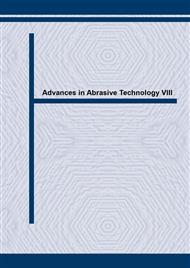p.253
p.259
p.265
p.271
p.275
p.281
p.287
p.291
p.297
Electrochemical Magnetic Abrasive Compound Finishing
Abstract:
In order to find a solution to the problem of inefficiency in magnetic abrasive finishing (MAF), electrochemical finishing (ECF) has been introduced to realize compound finishing. A new idea of integrating a magnetic pole with an electrode pole has been proposed as electrochemical magnetic abrasive finishing (ECMAF). At the same time, the occurrence of broken and dropped magnetic abrasives (MAs) has been discussed from the point of view of probability. Research on stock removal and surface roughness shows that the passive film has been removed continuously with a new substrate material emerging during the process of machining, which accelerates the process of electrochemistry to realize the surface finishing. The finishing efficiency and surface quality have been improved by the combination of MAF with the electrochemistry process, and the various cutting behaviors of MA in ECMAF.
Info:
Periodical:
Pages:
275-280
Citation:
Online since:
August 2005
Authors:
Keywords:
Price:
Сopyright:
© 2005 Trans Tech Publications Ltd. All Rights Reserved
Share:
Citation:


